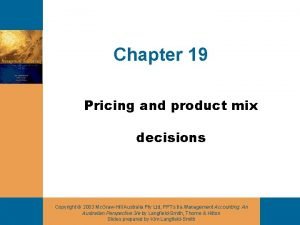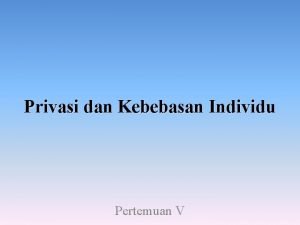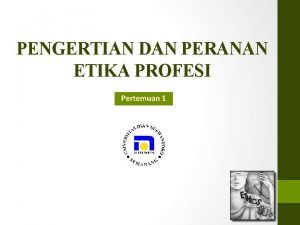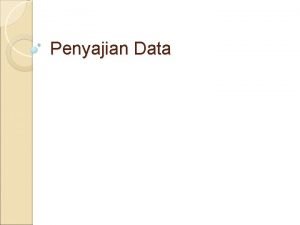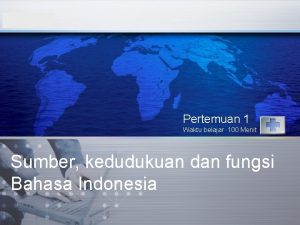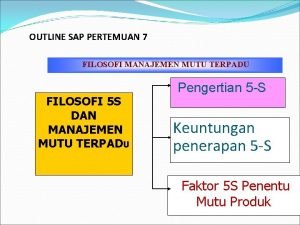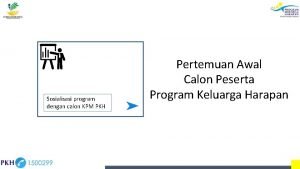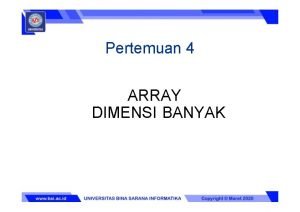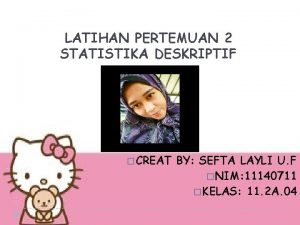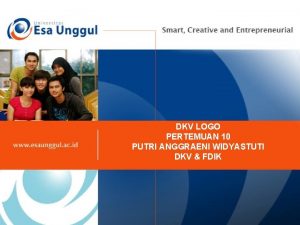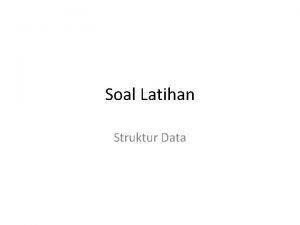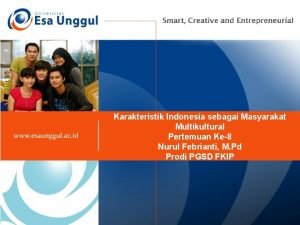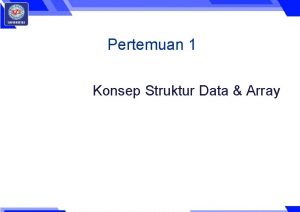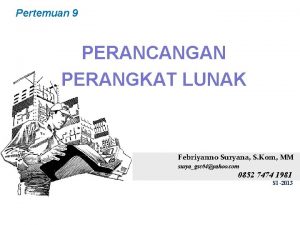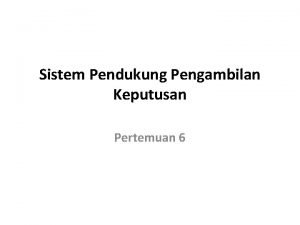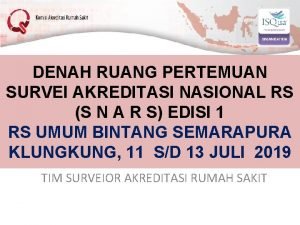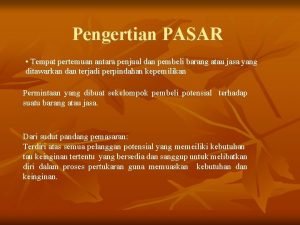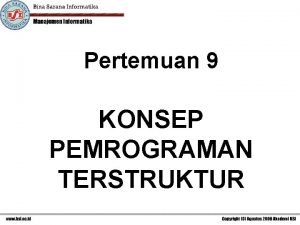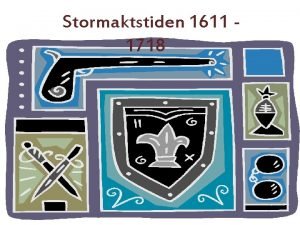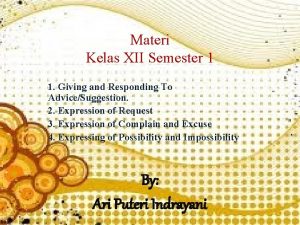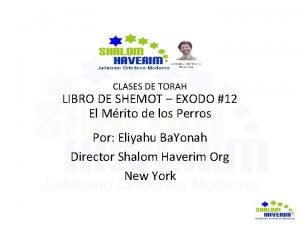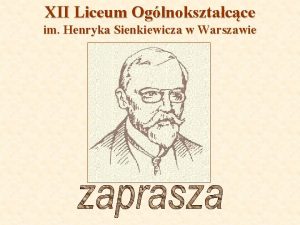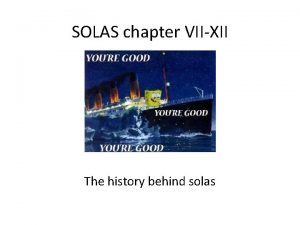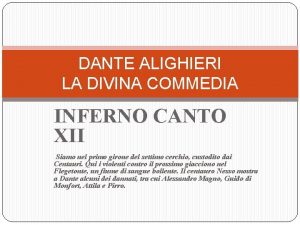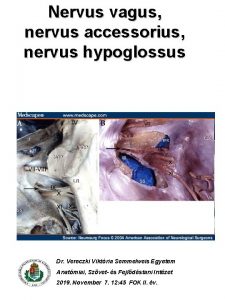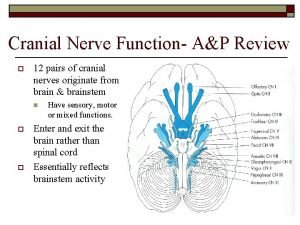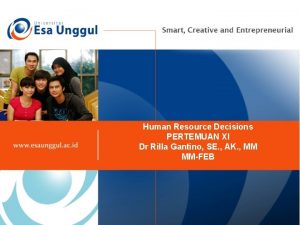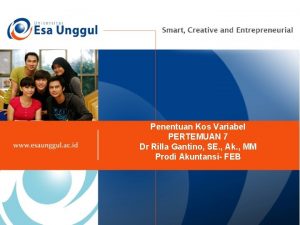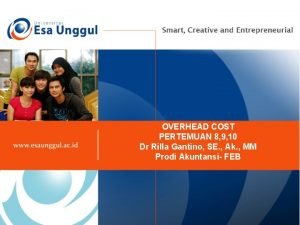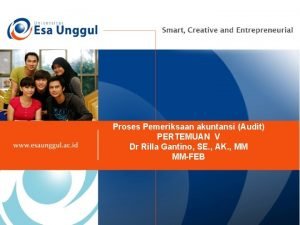Accounting Decisions PERTEMUAN XII Dr Rilla Gantino SE















































- Slides: 47

Accounting Decisions PERTEMUAN XII Dr Rilla Gantino, SE. , AK. , MM MM-FEB

KEMAMPUAN AKHIR YANG DIHARAPKAN Mahasiswa mengetahui tentang klasifikasi cost dan mengetahui tentang mengkalkulasi biaya produksi baik untuk jasa maupun produk. Mengetahui tentang metode alokasi overhead serta konsep Contingency berkait dengan informasi yang dibutuhkan management dalam menghadapi ketidakpastian

Decisions • A decision model is a formal method of making a choice, often involving both quantitative and qualitative analyses • A relevant cost is a cost that differs between alternatives.

Five-Step Decision-Making Process

Relevance • Relevant Information has two characteristics: – It occurs in the future – It differs among the alternative courses of action • Relevant Costs – expected future costs • Relevant Revenues – expected future revenues

Identifying Relevant Costs that can be eliminated (in whole or in part) by choosing one alternative over another are avoidable costs. Avoidable costs are relevant costs. Unavoidable costs are never relevant and include: Sunk costs. Future costs that do not differ between the alternatives.

Identifying Relevant Costs • gather all costs associated with the alternatives • eliminate all sunk costs • Eliminate all future costs that don’t differ between alternatives • left are the avoidable costs

Irrelevance • Historical costs are past costs that are irrelevant to decision making – Also called Sunk Costs- cost that has already been incurred and that cannot be avoided regardless of what a manager decides to do

Types of Information • Quantitative factors are outcomes that can be measured in numerical terms • Qualitative factors are outcomes that are difficult to measure accurately in numerical terms, such as satisfaction – Are just as important as quantitative factors even though they are difficult to measure

Terminology • Incremental Cost – the additional total cost incurred for an activity • Differential Cost – the difference in total cost between two alternatives • Incremental Revenue – the additional total revenue from an activity • Differential Revenue – the difference in total revenue between two alternatives

Types of Decisions • • One-Time-Only Special Orders Insourcing vs. Outsourcing Make or Buy Product-Mix Customer Profitability Branch / Segment: Adding or Discontinuing Equipment Replacement

One-Time-Only Special Orders • Accepting or rejecting special orders when there is idle production capacity and the special orders have no long-run implications • Decision Rule: does the special order generate additional operating income? – Yes – accept – No – reject

One-Time-Only Special Orders • Compares relevant revenues and relevant costs to determine profitability

Special Orders • Acki Company receives a one-time order that is not considered part of its normal ongoing business. • Acki Company only produces one type of silver key chain with a unit variable cost of TL 16. Normal selling price is TL 40 per unit. • A company in KKTC offers to purchase 3, 000 units for TL 20 per unit. • Annual capacity is 10, 000 units, and annual fixed costs total TL 78, 000, but Acki company is currently producing and selling only 5, 000 units. Should Acki accept the offer?

Special Orders

Special Orders If Acki accepts the offer, net income will increase by TL 12. 000. Using the incremental approach: Special order contribution margin = TL 20 – TL 16 = TL 4 Change in income = TL 4 × 3, 000 units = TL 12. 000.

Potential Problems with Relevant-Cost Analysis • Avoid incorrect general assumptions about information, especially: – “All variable costs are relevant and all fixed costs are irrelevant” – There are notable exceptions for both costs

Potential Problems with Relevant-Cost Analysis • Problems with using unit-cost data: – Including irrelevant costs in error – Using the same unit-cost with different output levels • Fixed costs per unit change with different levels of output

Avoiding Potential Problems with Relevant-Cost Analysis • Focus on Total Revenues and Total Costs, not their per-unit equivalents • Continually evaluate data to ensure that they meet the requirements of relevant information

Insourcing vs. Outsourcing • Insourcing – producing goods or services within an organization • Outsourcing – purchasing goods or services from outside vendors • Also called the “Make or Buy” decision • Decision Rule: Select the option that will provide the firm with the lowest cost, and therefore the highest profit.

Qualitative Factors • Nonquantitative factors may be extremely important in an evaluation process, yet do not show up directly in calculations: – Quality Requirements – Reputation of Outsourcer – Employee Morale – Logistical Considerations – distance from plant, etc.

Opportunity Costs • Opportunity Cost is the contribution to operating income that is forgone by not using a limited resource in its next-best alternative use – “How much profit did the firm ‘lose out on’ by not selecting this alternative? ” – The economic benefits that are foregone as a result of pursuing some course of action. Opportunity costs are not actual dollar outlays and are not recorded in the accounts of an organization. • Special type of Opportunity Cost: Holding Cost for Inventory. Funds tied up in inventory are not available for investment elsewhere

The Make or Buy Decision A decision concerning whether an item should be produced internally or purchased from an outside supplier is called a “make or buy” decision.

The Make or Buy Decision • MA Company is thinking of buying a part that is currently used in one of its products from outside. • The unit cost to make this part is:

The Make or Buy Decision • General factory overhead is allocated on the basis of direct labor hours and is not going to change if the parts are bought from outside. • The 90 TL unit cost is based on 20, 000 parts produced each year. • An outside supplier has offered to provide the 20, 000 parts at a cost of 70 TL per part. Should we accept the supplier’s offer?

The Make or Buy Decision Sunk Cost Not avoidable and is irrelevant. If the product is dropped, it will be reallocated to other products.

The Make or Buy Decision DECISION RULE In deciding whether to accept the outside supplier’s offer, MA isolated the relevant costs of making the part by eliminating: eliminating – The sunk costs. – The future costs that will not differ between making or buying the parts.

Product-Mix Decisions • The decisions made by a company about which products to sell and in what quantities • Decision Rule (with a constraint): choose the product that produces the highest contribution margin per unit of the constraining resource

Utilization of a Constrained Resource • Firms often face the problem of deciding how to best utilize a constrained resource. • Usually, fixed costs are not affected by this particular decision, so management can focus on maximizing total contribution margin.

Utilization of a Constrained Resource UM Company produces two products and selected data is shown below:

Utilization of a Constrained Resource • Machine A 1 is the constrained resource. There is excess capacity on all other machines. Machine A 1 is being used at 100% of its capacity, and has a capacity of 2, 400 minutes per week. Should UM focus its efforts on Product 1 or 2?

Utilization of a Constrained Resource Let’s calculate the contribution margin per unit of the constrained resource, machine A 1. Product 2 should be emphasized. Provides more valuable use of the constrained resource machine A 1, yielding a contribution margin of TL 30 per minute as opposed to TL 24 for Product 1.

Utilization of a Constrained Resource Let’s calculate the contribution margin per unit of the scarce resource, machine A 1. Let’s see how this plan would work. If there are no other considerations, the best plan would be to produce to meet current demand for Product 2 and then use remaining capacity to make Product 1.

Utilization of a Constrained Resource Let’s see how this plan would work.

Utilization of a Constrained Resource According to the plan, we will produce 2, 200 units of Product 2 and 1, 300 of Product 1. Our contribution margin looks like this. The total contribution margin for UM is TL 64, 200.

Managing Constraints Finding ways to process more units through a resource bottleneck Produce only what can be sold. At the bottleneck itself: • Improve the process • Add overtime or another shift • Hire new workers or acquired more machines • Subcontract production Eliminate waste. Streamline production process.

Adding or Dropping Customers • Decision Rule: Does adding or dropping a customer add operating income to the firm? – Yes – add or don’t drop – No – drop or don’t add • Decision is based on profitability of the customer, not how much revenue a customer generates

Adding or Discontinuing Branches or Segments • Decision Rule: Does adding or discontinuing a branch or segment add operating income to the firm? – Yes – add or don’t discontinue – No – discontinue or don’t add • Decision is based on profitability of the branch or segment, not how much revenue the branch or segment generates

Adding/Dropping Segments Should the company drop digital instruments division? General Factory Overhead and General Administrative Expenses are unavoidable costs. Assume that the equipment used in manufacturing digital instruments has no resale value or alternative use.

Incremental Approach DECISION RULE UM should drop the digital instruments division only if the avoided fixed costs of the division exceed lost contribution margin of this division.

Incremental Approach What about depreciation?

Comparative Income Approach Prepare comparative income statements showing results with and without the digital instruments division.


Joint Product Costs • In some industries, a number of end products are produced from a single raw material input. • Two or more products produced from a common input are called joint products • The point in the manufacturing process where each joint product can be recognized as a separate product is called the split-off point

Joint Products Joint Input Joint Costs Oil Common Production Process Gasoline Chemicals Split-Off Point

Joint Products Joint Costs Joint Input Common Production Process Oil Gasoline Chemicals Split-Off Point Separate Processing Final Sale Separate Processing Separate Product Costs Final Sale

The Pitfalls of Allocation of Joint Costs • Joint costs are really common costs incurred to simultaneously produce a variety of end products. • Joint costs are often allocated to end products on the basis of the relative sales value of each product or on some other basis.
 Rilla gantino
Rilla gantino Rilla gantino
Rilla gantino Se audit
Se audit Good decision making poster
Good decision making poster Screening decisions and preference decisions
Screening decisions and preference decisions Cost plus pricing formula
Cost plus pricing formula Tester
Tester Apa itu etiket
Apa itu etiket Apakah pengertian diagram batang
Apakah pengertian diagram batang Sel adalah pertemuan antara titik-titik dan titik-titik
Sel adalah pertemuan antara titik-titik dan titik-titik Pleonasme
Pleonasme Filosofi pertemuan
Filosofi pertemuan Susunan acara pkh
Susunan acara pkh Pendekatan kontribusi adalah
Pendekatan kontribusi adalah Array dimensi banyak
Array dimensi banyak Creat by
Creat by Logo pertemuan
Logo pertemuan Dari gambar ini maka notasi infix yang dihasilkan adalah
Dari gambar ini maka notasi infix yang dihasilkan adalah Pertemuan multikultural
Pertemuan multikultural Apakah struktur sederhana dalam array
Apakah struktur sederhana dalam array Pada pertemuan kali ini kita
Pada pertemuan kali ini kita Pertemuan permintaan barang dan jasa
Pertemuan permintaan barang dan jasa Tugas pertemuan 9 metode perancangan program
Tugas pertemuan 9 metode perancangan program Spk latihan pertemuan 6
Spk latihan pertemuan 6 Denah ruang pertemuan
Denah ruang pertemuan Sell adalah pertemuan antara
Sell adalah pertemuan antara Pertemuan 9
Pertemuan 9 Planta gotica
Planta gotica Karl xii
Karl xii Materi kelas 12 semester 1
Materi kelas 12 semester 1 Clemens 12 pont max
Clemens 12 pont max Materi kelas xii semester 1
Materi kelas xii semester 1 Xii tablas
Xii tablas Ad altare dei
Ad altare dei Stalag xii d
Stalag xii d Shemot (éxodo) xii (22 - 27)
Shemot (éxodo) xii (22 - 27) Xii lo im henryka sienkiewicza
Xii lo im henryka sienkiewicza Nervus xii
Nervus xii Xii lo toruń
Xii lo toruń Fons omnis publici privatique iuris
Fons omnis publici privatique iuris Lecturas domingo xvii tiempo ordinario ciclo b
Lecturas domingo xvii tiempo ordinario ciclo b Sonnet xii
Sonnet xii Solas chapter xii
Solas chapter xii Roman number 1 to 12
Roman number 1 to 12 Xii number
Xii number I centauri divina commedia
I centauri divina commedia Vms anatomia
Vms anatomia Testing vestibulocochlear nerve
Testing vestibulocochlear nerve





